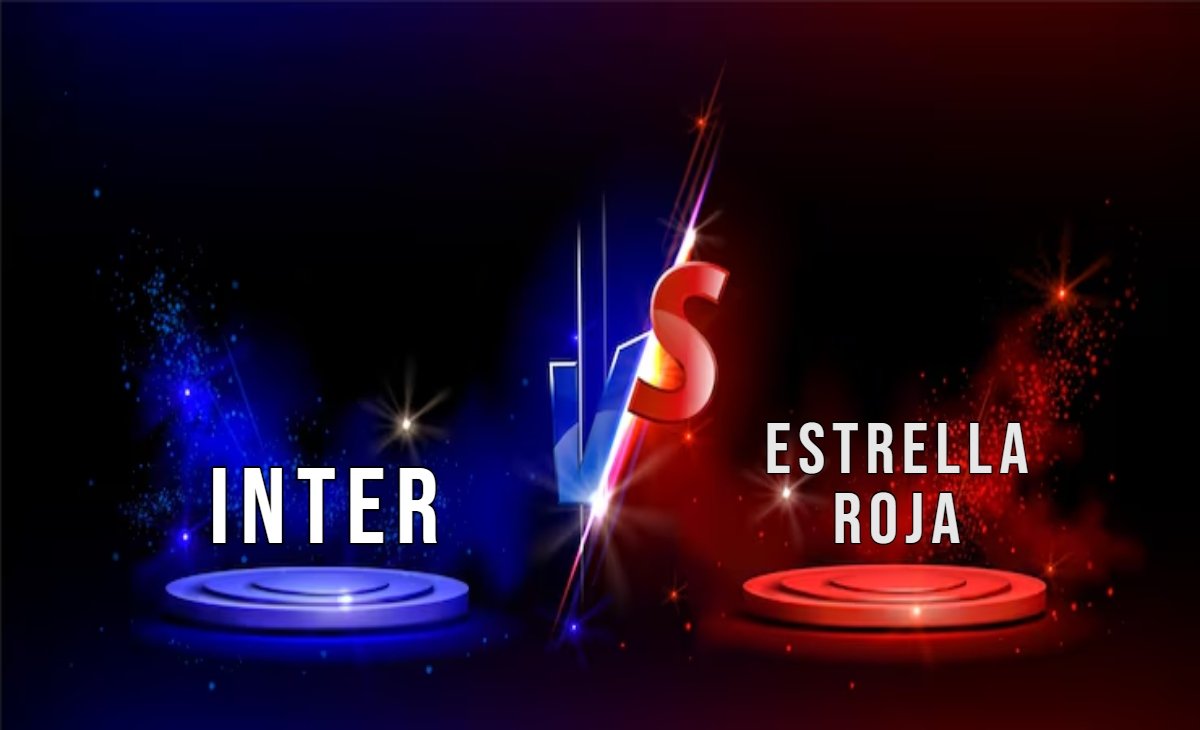Few fixtures in European football generate as much intrigue and cultural significance as Inter vs. Estrella Roja. When two storied clubs meet on the pitch, it’s more than just a contest of skill—it’s a moment where history, pride, passion, and identity converge. Inter Milan, one of Italy’s most prestigious and globally recognized football clubs, comes face-to-face with Estrella Roja, also known as Red Star Belgrade, a team deeply rooted in Balkan pride and legacy.
This matchup captures the imagination not just because of the caliber of players involved, but because of the contrasting football philosophies, fan cultures, and historical trajectories each club represents. Inter Milan, with its consistent European pedigree, tactical discipline, and international flair, stands in contrast to Estrella Roja’s fierce nationalism, technical resilience, and unrelenting home support. Their clash brings together worlds that rarely meet, offering fans a spectacle that transcends the ninety minutes on the pitch.
History of Inter Milan
Inter Milan, officially known as Football Club Internazionale Milano, was founded in 1908 and has since grown into one of Italy’s most successful and iconic football clubs. The Nerazzurri have won multiple Serie A titles, domestic cups, and European trophies, including three UEFA Champions League crowns. Their distinctive black and blue stripes have become a symbol of tactical mastery and internationalism.
Inter’s playing philosophy has historically revolved around strong defensive organization, famously characterized by the catenaccio system during their 1960s glory years under Helenio Herrera. Over time, they’ve evolved into a more fluid, attacking team, adapting to modern football while retaining a foundation of discipline and structure.
Inter’s appeal goes beyond Italy. With a diverse roster of international talent, the club has cultivated a global following. Their home, the iconic San Siro Stadium, is a temple of football tradition, echoing with decades of drama, glory, and unforgettable moments.
History of Estrella Roja
Estrella Roja, known globally as Red Star Belgrade, is a symbol of Serbian football and one of the most decorated clubs in the Balkan region. Founded in 1945 in the aftermath of World War II, the club quickly became a dominant force in Yugoslav and later Serbian football. Their crowning achievement came in 1991 when they won the European Cup, defeating Olympique Marseille in the final. That historic win marked them as one of the elite few from Eastern Europe to conquer continental football.
The team is known for its passionate fanbase, the Delije, who create one of the most intimidating atmospheres in European football. The Marakana Stadium, officially named Rajko Mitić Stadium, has witnessed decades of fierce rivalries and breathtaking victories. Estrella Roja’s playing style often combines technical proficiency with physical intensity, shaped by the resilient spirit of the Serbian people.
In modern times, the club has had to adapt to financial limitations and the changing landscape of European football. Yet it continues to punch above its weight, producing top talent and competing with giants on the European stage.
Inter vs. Estrella Roja: First Meetings
Inter vs. Estrella Roja is not a fixture that occurs frequently, making each meeting special. When the two sides do meet, it is often in European competitions such as the UEFA Champions League or the Europa League. Their first meetings were marked by intensity, with Inter’s structured and star-studded lineups clashing against the gritty and determined style of Estrella Roja.
The tactical matchups in those encounters are often fascinating. Inter’s midfield orchestration and use of width contrast starkly with Estrella Roja’s more direct and physical approach. Watching these teams share the same pitch is like observing a football masterclass in contrasting ideologies.
Though Inter usually enters such encounters as the favorite due to their resources and experience, Estrella Roja never backs down. Their performances, especially at home, are fueled by the energy of their supporters and a deep-rooted sense of national pride.
Fan Culture and Stadium Atmosphere
Inter’s fans, known as the Curva Nord, are passionate and fiercely loyal. On matchdays, the San Siro turns into a sea of blue and black, with choreographed displays, chants, and unwavering support for their team. The Inter faithful expect quality and consistency, and their presence can lift the players during crucial moments.
On the other side, Estrella Roja boasts one of the most intense fan cultures in Europe. The Delije are infamous for their pyrotechnic displays, synchronized chants, and fierce devotion. When Inter vs. Estrella Roja is played in Belgrade, the atmosphere is electric and sometimes intimidating. The noise, the flags, and the relentless support create an environment where visiting teams often struggle to impose themselves.
These fanbases reflect their clubs’ identities. Inter’s supporters embody sophistication, internationalism, and high expectations. Estrella Roja’s fans represent resilience, tradition, and raw passion. When these cultures clash, the resulting energy is unforgettable.
Tactical Breakdown of Inter Milan
Inter Milan typically operates with a fluid 3-5-2 or 3-4-2-1 formation under modern tactical systems. The use of wing-backs allows for width while maintaining a solid defensive core. Players like Denzel Dumfries or Federico Dimarco provide attacking thrust from the flanks, while central midfielders such as Nicolò Barella or Hakan Çalhanoğlu orchestrate play and maintain tempo.
Defensively, Inter remains one of the most structured teams in Europe. Their back three are tasked with both marking and building from the back. The goalkeeper, often a vocal leader, contributes significantly to organizing the backline and initiating counterattacks.
In the context of Inter vs. Estrella Roja, Inter would likely aim to dominate possession, stretch the field wide, and exploit gaps in transition. Their experience in European competition gives them a psychological edge, especially in managing the tempo and neutralizing pressure in hostile environments.
Tactical Breakdown of Estrella Roja
Estrella Roja often lines up in a 4-2-3-1 or 4-4-2 formation, emphasizing compactness and transition. Their defenders are strong in the tackle and aerial duels, while their midfielders excel at pressing and disrupting the opponent’s rhythm. In attack, the focus is on quick counters, often using pacey wingers and a strong central forward.
Set pieces are a key weapon in Estrella Roja’s arsenal. With good height across the team and accurate delivery, they can turn dead-ball situations into scoring chances. Their midfield is industrious, tasked with both shielding the defense and launching fast breaks.
Against a team like Inter, Estrella Roja would likely sit deeper, absorb pressure, and look to hit on the break. At home, however, they might press higher, banking on their fans to energize the players and unsettle the visitors early.
Key Players to Watch
In any Inter vs. Estrella Roja matchup, certain players tend to rise above the rest. For Inter, strikers like Lautaro Martínez or Marcus Thuram provide the cutting edge in attack. Their ability to find space and finish clinically makes them constant threats. Midfield leaders like Barella offer vision and drive, while defenders such as Alessandro Bastoni add composure and ball-playing ability.
Estrella Roja typically fields a blend of experienced campaigners and emerging talents. A talismanic forward, a tenacious box-to-box midfielder, and a commanding center-back usually form the spine of the team. Their captain often leads by example, rallying the team during key moments.
Goalkeepers on both sides can play decisive roles, especially in tight matches where one save can turn the tide. A spectacular save or a lapse in concentration could determine the outcome in a contest as finely balanced as Inter vs. Estrella Roja.
Memorable Moments from Past Encounters
When Inter vs. Estrella Roja has taken place in the past, there have been dramatic goals, red cards, late comebacks, and tactical masterclasses. One particularly memorable match featured a dramatic penalty shootout after a closely fought two-legged tie, with emotions running high on both sides.
Another iconic moment came when Estrella Roja scored an unexpected equalizer in Milan, silencing the San Siro and reminding everyone that no opponent should be underestimated in European football.
For Inter fans, victories over Estrella Roja are cherished not just for the result but for the challenge presented by a side that plays with pride and tenacity. For Estrella Roja supporters, even narrow defeats against Inter are seen as battles won in spirit, showcasing their team’s ability to compete with the very best.
Broadcast and Global Appeal
An Inter vs. Estrella Roja match draws global attention. Fans from Italy, Serbia, and beyond tune in to witness a unique football spectacle. Broadcasters highlight the historical context, the tactical intrigue, and the passionate fanbases, making it a highlight of the European football calendar.
Social media buzz, live commentary, and expert analysis build anticipation before the match and keep the conversation alive long after the final whistle. It’s not just a game—it’s an event, one that reflects the diversity and drama that football uniquely delivers.
Cultural Impact of the Fixture
This fixture is more than football. It represents a meeting of two cultures with rich histories, proud identities, and deep emotional investments in the game. For many fans, Inter vs. Estrella Roja symbolizes East versus West, tradition versus modernity, and passion versus pragmatism.
Children who grow up watching these matches often carry the memories into adulthood, shaping their love for the game and their understanding of competition and respect. The cultural exchange that occurs, even through the lens of football, fosters a connection that transcends politics or language barriers.
Conclusion
The clash between Inter vs. Estrella Roja goes beyond points, trophies, or rankings. It is a footballing experience filled with emotion, intensity, and historical weight. Each time these two clubs meet, fans are treated to a spectacle that encapsulates the beauty of the sport. From the tactical battles on the pitch to the roaring anthems in the stands. This matchup continues to inspire, captivate, and unite fans across the world.
In a sport increasingly driven by commercial interests, fixtures like Inter vs. Estrella Roja remind us why we fell in love with football in the first place. It is a celebration of heritage, a test of character, and above all, a beautiful game played with heart and soul.








